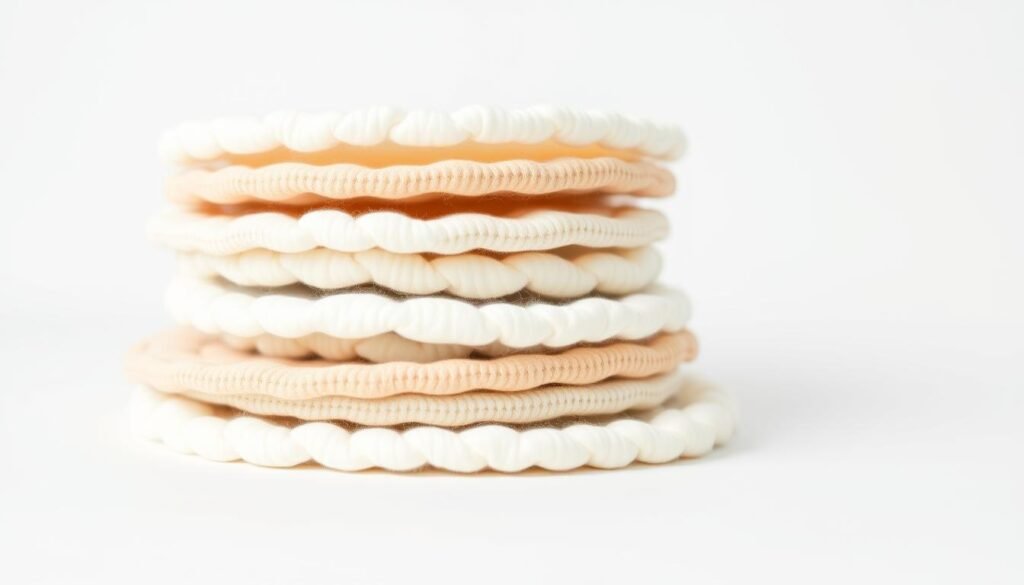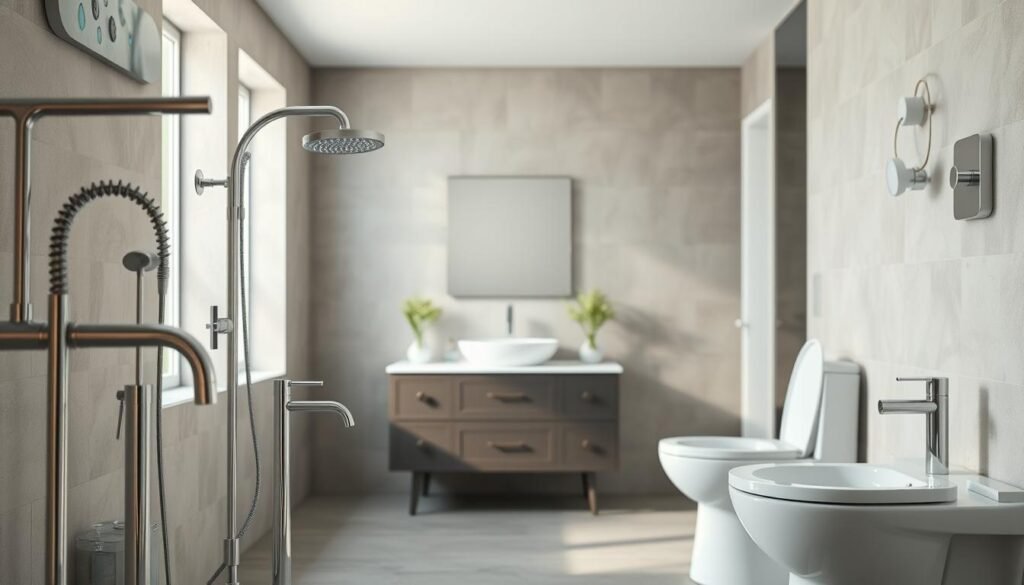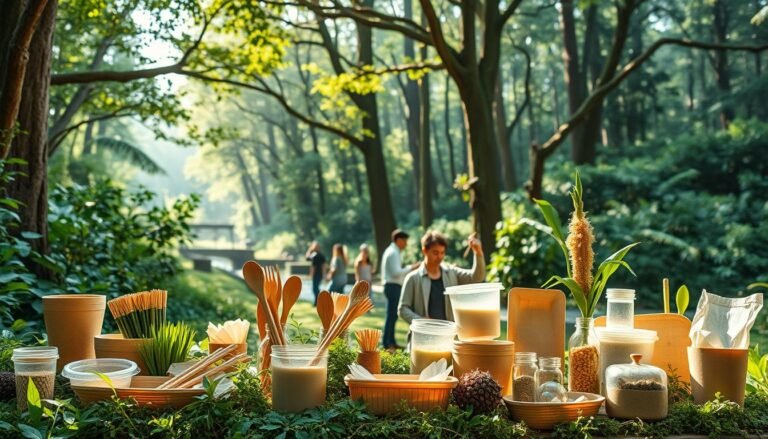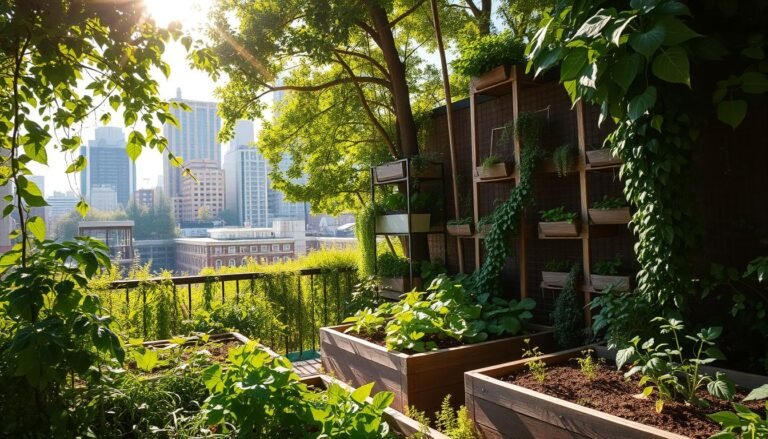Making a few simple changes in your daily routine can significantly reduce plastic waste. The bathroom is one of the easiest places to start your zero-waste journey.
By introducing eco alternatives into your daily habits, you can make a positive impact on the environment. It’s easier than you think to make sustainable choices that benefit both you and the planet.
Key Takeaways
- Simple swaps can make a big difference in reducing plastic waste.
- Eco-friendly bathroom alternatives are easy to incorporate into your daily routine.
- Making sustainable choices benefits both you and the environment.
- Reducing waste in the bathroom is a great starting point for a zero-waste lifestyle.
- Small changes can lead to significant positive impacts over time.
The Environmental Cost of Conventional Bathroom Products
Every day, our bathroom habits contribute to plastic pollution and chemical runoff, significantly impacting the environment. The products we use, from toothbrushes to shower gels, play a substantial role in this ecological footprint.
Plastic Pollution from Daily Essentials
Daily bathroom essentials, such as toothbrushes, razors, and packaging from personal care products, contribute to the staggering amount of plastic waste. It’s estimated that a significant portion of plastic pollution comes from such disposable items. Switching to sustainable alternatives can greatly reduce this environmental burden.
Chemical Runoff and Water System Impact
Chemicals from conventional bathroom products, including soaps and shampoos, often end up in our water systems. These chemicals can harm aquatic life and contaminate water sources. The environmental cost of these products extends beyond plastic waste to include the pollution of our waterways.
By understanding the environmental impact of our bathroom choices, we can begin to make more sustainable decisions, reducing both plastic pollution and chemical runoff.
Benefits of Switching to Eco-Friendly Bathroom Alternatives
Making the switch to eco-friendly bathroom alternatives offers numerous benefits for both personal health and the environment. Eco-friendly bathroom products are designed to reduce environmental impact while promoting healthier living.
One of the significant health benefits of eco-friendly bathroom products is the reduction in exposure to harsh chemicals. Conventional bathroom products often contain chemicals that can irritate skin and respiratory systems. In contrast, eco-friendly alternatives are typically made with natural ingredients that are gentler on the skin.
In addition to the health advantages, eco-friendly bathroom products can also lead to cost savings in the long run. Many eco-friendly products are designed to be more concentrated or come in refillable packaging, reducing waste and the need for frequent purchases.
By choosing eco-friendly bathroom alternatives, individuals can contribute to a more sustainable future while also enjoying the benefits of healthier living and potential cost savings. It’s a straightforward way to make a positive impact on both personal well-being and the environment.
Sustainable Bathroom Swaps That Work for Everyday Use
Sustainable bathroom swaps offer a simple yet effective way to make your daily routine more eco-friendly. By incorporating eco alternatives into your bathroom habits, you can significantly reduce your environmental footprint.
Criteria for Truly Effective Eco Alternatives
Effective eco alternatives must meet certain criteria to be viable for everyday use. They should be made from sustainable materials, be free from harsh chemicals, and have minimal packaging. Moreover, they need to be as effective as their conventional counterparts to ensure a seamless transition.
- Made from sustainable, renewable resources
- Free from harsh chemicals and toxins
- Minimal or biodegradable packaging
- Comparable in performance to traditional products
Balancing Sustainability with Practicality
Balancing sustainability with practicality is crucial for the successful adoption of eco-friendly bathroom swaps. It’s about finding products that are not only good for the environment but also fit into your lifestyle and budget. For instance, opting for refillable options or products with longer shelf lives can be both eco-friendly and cost-effective.
Making Gradual Changes That Stick
Making gradual changes is key to adopting sustainable bathroom swaps that stick. Start by replacing one or two products at a time, and gradually work your way up to more significant changes. This approach helps in adjusting to new product textures, scents, and application methods, making the transition smoother.
- Identify the products you use most frequently.
- Research eco-friendly alternatives for these products.
- Gradually replace traditional products with eco-friendly ones.
By understanding the criteria for effective eco alternatives, balancing sustainability with practicality, and making gradual changes, you can successfully integrate sustainable bathroom swaps into your daily routine. This not only benefits the environment but also contributes to a healthier, more sustainable lifestyle.
Transforming Your Oral Care Routine
Revolutionizing your oral care routine can be as simple as switching to eco-friendly alternatives. By making a few conscious changes, you can significantly reduce your environmental footprint while maintaining good oral hygiene.
Bamboo Toothbrushes: Options for Every Preference
Bamboo toothbrushes are a popular alternative to traditional plastic toothbrushes. They are biodegradable, compostable, and often come with replaceable heads. Brands like The Humble Co. and Brush with Bamboo offer a range of styles and bristle types to suit different needs. As “the future of oral care is in sustainable materials”, bamboo toothbrushes are leading the way.
Plastic-Free Dental Floss Alternatives
Traditional dental floss is often made from nylon or other synthetic materials that are not biodegradable. Switching to plastic-free dental floss alternatives like silk or bamboo floss can make a significant difference. These eco-friendly options are not only better for the environment but also just as effective for your oral health.
Toothpaste Tablets, Powders, and Glass Jar Options
Toothpaste tablets and powders are gaining popularity as they eliminate the need for plastic toothpaste tubes. Many of these products come in glass jars or compostable packaging, further reducing waste. Brands are now offering a variety of flavors and formulations, making it easier to find a product that suits your preferences. As noted by a recent study,
“toothpaste tablets have been shown to be just as effective as traditional toothpaste in maintaining oral hygiene.”
With the added benefit of reduced plastic waste, these alternatives are a step in the right direction for eco-conscious consumers.
By incorporating these eco-friendly oral care products into your daily routine, you can contribute to a more sustainable future. Every small change counts, and transforming your oral care routine is a great place to start.
Shower Essentials for a Zero Waste Bathroom
Transforming your shower routine is a crucial step towards achieving a zero waste bathroom. By making a few simple swaps, you can significantly reduce your environmental footprint.
Solid Shampoo and Conditioner Bars
Solid shampoo and conditioner bars are an excellent alternative to traditional liquid products. They come with minimal packaging, reducing plastic waste. To use them effectively, it’s essential to understand how to store and apply them properly.
How to Use and Store Properly
To get the most out of your solid shampoo and conditioner bars, make sure to store them in a dry, well-ventilated area. This helps prevent them from becoming soggy. When using, simply wet your hair, rub the bar between your hands or directly on your hair, and lather as usual.
Australian Brands to Try
Some popular Australian brands offering solid shampoo and conditioner bars include:
- Unilever’s Love Beauty and Planet
- Meadowbrook Soapworks
- Soap Kitchen Australia
Natural Loofahs and Biodegradable Body Scrubbers
Switching to natural loofahs and biodegradable body scrubbers is another way to make your shower routine more sustainable. These products are gentle on the skin and the environment. Natural loofahs are particularly effective for exfoliating and can be composted at the end of their life cycle.
Safety Razors and Plastic-Free Shaving Solutions
Safety razors offer a plastic-free shaving solution that is both effective and sustainable. They use replaceable blades, significantly reducing the amount of waste generated by disposable razors. Many safety razors are made from durable materials like stainless steel, making them a long-lasting option.
Some key benefits of safety razors include:
- Reduced plastic waste
- Cost-effective in the long run
- Close shave quality
Green Hygiene Products That Actually Work
Green hygiene products are revolutionizing personal care by offering sustainable alternatives that actually work. These products not only reduce environmental impact but also provide effective solutions for personal hygiene.
Menstrual Cups, Period Underwear and Reusable Pads
Menstrual cups, period underwear, and reusable pads are changing the way we manage menstruation. Menstrual cups, made from medical-grade silicone, can be worn for up to 12 hours and are a game-changer for many. Period underwear offers comfort and protection, while reusable pads provide an eco-friendly alternative to disposable products. These options significantly reduce waste and are more cost-effective in the long run.
| Product | Benefits | Environmental Impact |
|---|---|---|
| Menstrual Cups | Up to 12 hours of protection, cost-effective | Reduces disposable pad waste |
| Period Underwear | Comfortable, protective, and stylish | Reduces disposable pad and tampon waste |
| Reusable Pads | Eco-friendly, cost-effective | Significantly reduces disposable pad waste |
Reusable Cotton Rounds for Skincare
Reusable cotton rounds are a simple swap for skincare routines. Made from soft cotton, these rounds can be used with your favorite cleansers and toners, then washed and reused multiple times. This switch reduces the number of disposable cotton pads that end up in landfills.

Natural Deodorants in Plastic-Free Packaging
Natural deodorants in plastic-free packaging are gaining popularity. These deodorants use natural ingredients to keep you fresh without the harmful chemicals found in some conventional deodorants. By choosing products in recyclable or biodegradable packaging, you’re further reducing your environmental footprint.
By incorporating these green hygiene products into your daily routine, you’re not only improving your personal care but also contributing to a more sustainable future.
Eco-Friendly Bathroom Cleaning Solutions
Cleaning your bathroom sustainably is easier than you think, with simple DIY cleaners and reusable tools making a big impact. By switching to eco-friendly cleaning methods, you can significantly reduce your environmental footprint.
DIY Cleaners Using Pantry Ingredients
Creating your own cleaning solutions using pantry ingredients is not only cost-effective but also ensures you’re avoiding harsh chemicals. Common ingredients like baking soda, vinegar, and lemon juice can be used to clean various surfaces.
Basic Recipes for All Surfaces
For a general-purpose cleaner, mix equal parts water and white vinegar in a spray bottle. For tougher grime, a paste made from baking soda and water can be effective. Lemon juice is great for leaving surfaces smelling fresh.
Storage and Safety Tips
Always store your homemade cleaners in labeled containers and keep them out of reach of children and pets. Be sure to test a small area first to ensure the solution doesn’t damage the surface you’re cleaning.
Reusable Cleaning Tools That Last
Investing in reusable cleaning tools like microfiber cloths, scrubbers, and bamboo brushes can significantly reduce waste. These tools are not only durable but also effective at cleaning various bathroom surfaces.
By combining DIY cleaners with reusable tools, you can maintain a clean and hygienic bathroom while minimizing your environmental impact.
Sustainable Toilet Paper and Alternatives
As Australians become more environmentally conscious, the demand for sustainable toilet paper options is on the rise. Traditional toilet paper production contributes to deforestation and water pollution, making eco-friendly alternatives an attractive choice for those looking to reduce their environmental footprint.
Bamboo and Recycled Paper Options in Australia
Australia offers a range of sustainable toilet paper options made from bamboo and recycled paper. Bamboo toilet paper is particularly noteworthy as bamboo is a highly renewable resource that requires less water to grow compared to traditional wood pulp. Brands offering bamboo toilet paper are becoming increasingly popular, providing a soft, durable, and eco-friendly alternative. Recycled paper toilet paper, on the other hand, reduces the demand for virgin wood pulp and helps in minimizing waste.
Modern Bidet Attachments for Australian Bathrooms
Another innovative alternative to traditional toilet paper is the use of bidet attachments. Modern bidet attachments are designed to be easy to install and use, offering a hygienic and water-efficient solution. They not only reduce the need for toilet paper but also provide a more thorough cleaning experience. For Australians looking to make a significant impact on their bathroom’s sustainability, bidet attachments are a worthwhile consideration.
By embracing sustainable toilet paper options or installing bidet attachments, Australians can make a positive impact on the environment. These alternatives not only reduce deforestation and water consumption but also promote a more sustainable lifestyle.
Water Conservation Strategies for Australian Homes
Conserving water is essential for Australian homes, and there are several effective strategies to achieve this. As water scarcity becomes an increasingly pressing issue, households can make a significant impact by adopting simple yet effective conservation methods.
Low-Flow Fixtures That Don’t Sacrifice Performance
One of the most effective ways to conserve water is by installing low-flow fixtures. These include showerheads, taps, and toilets that use significantly less water without compromising performance. For example, a low-flow showerhead can reduce water usage by up to 50%.

Greywater Systems Suitable for Australian Regulations
Greywater systems are another excellent way to conserve water. These systems reuse water from sinks, showers, and washing machines for irrigation and flushing toilets. In Australia, greywater systems must comply with local regulations, so it’s essential to check with your local authority before installation. For more information on the benefits of water conservation, visit The Power of Saving Water at.
Daily Habits to Reduce Water Waste
Simple changes to daily habits can also significantly reduce water waste. Turning off the tap while brushing teeth, taking shorter showers, and fixing leaks promptly are all effective ways to conserve water. By making these habits a part of your daily routine, you can contribute to a more sustainable future.
| Conservation Method | Water Savings |
|---|---|
| Low-flow showerheads | Up to 50% |
| Greywater systems | Up to 30% |
| Daily habit changes | Up to 20% |
Plastic-Free Bathroom Storage and Organisation
Achieving a zero-waste bathroom requires more than just swapping products; it also involves rethinking how we store and organise our space. Effective plastic-free storage solutions can make a significant difference in maintaining a sustainable bathroom.
Glass and Stainless Steel Containers
One of the best ways to achieve plastic-free storage is by using glass containers. They are perfect for storing cotton balls, Q-tips, or bathroom essentials. Stainless steel containers are another excellent option, offering durability and a modern look. Both materials are non-toxic and can be recycled, making them ideal for an eco-friendly bathroom.
Bamboo and Wooden Organisers
Bamboo organisers bring a natural touch to your bathroom while keeping it tidy. Bamboo is a sustainable resource that is both durable and aesthetically pleasing. Wooden organisers can also add warmth and character to your bathroom. For more ideas on sustainable bathroom practices, you can visit Sustainable Jungle’s guide to a zero-waste.
Creative Upcycling Ideas for Bathroom Storage
Upcycling old items is a creative way to achieve plastic-free storage. Consider repurposing old mason jars, wooden crates, or even vintage furniture to store your bathroom essentials. This not only reduces waste but also adds a unique touch to your bathroom decor.
Australian-Made Sustainable Bathroom Products
As the world shifts towards a more sustainable future, Australian consumers are increasingly turning to locally-made sustainable bathroom products for a greener future. This trend is driven by a growing awareness of the environmental impact of our daily routines and a desire to reduce our ecological footprint.
Local Eco-Friendly Brands Making a Difference
Several Australian brands are leading the charge in sustainable bathroom products. Brands like Qui and Koio are making waves with their eco-friendly offerings, from bamboo toothbrushes to refillable soap dispensers. These brands are not only reducing waste but also promoting a more sustainable lifestyle.
As Emily Wilson, founder of Qui, notes, “Our goal is to make sustainable living accessible to everyone, starting with the smallest changes in our daily routines.” Such initiatives are crucial in driving the shift towards a more environmentally conscious consumer base.
Where to Shop for Zero Waste Bathroom Items
Finding zero-waste bathroom products is easier than ever, with numerous online retailers and physical stores across Australia offering a range of sustainable options.
Online Australian Retailers
- The Source Bulk Foods: Offers a range of zero-waste bathroom products, including bamboo toothbrushes and natural soaps.
- Eco Planet: Specializes in eco-friendly products, including sustainable bathroom essentials.
Brick-and-Mortar Stores by Region
For those preferring to shop in-store, cities like Melbourne and Sydney have numerous outlets dedicated to sustainable living. Good For in Melbourne is a notable example, offering a curated selection of eco-friendly bathroom products.
“The future of retail is sustainable, and it’s exciting to see consumers making conscious choices about their bathroom products,” says
.
By supporting Australian-made sustainable bathroom products, consumers are not only reducing their environmental impact but also contributing to the local economy. As the demand for eco-friendly products continues to grow, it’s likely that we’ll see even more innovative solutions emerge from local brands.
Overcoming Common Challenges When Going Green
Embracing sustainable living in the bathroom often comes with its own set of obstacles, yet it’s a worthwhile endeavor. As we transition to eco-friendly products and practices, we may encounter several challenges that can deter our progress.
Adjusting to New Product Textures and Applications
One of the initial hurdles is adapting to the different textures and applications of green bathroom products. For instance, switching from liquid shampoos to solid shampoo bars can require a period of adjustment. However, many users find that the benefits to the environment and their hair’s health make the transition worthwhile.
Managing the Initial Investment Costs
The initial investment in eco-friendly bathroom products can sometimes be higher than conventional products. However, it’s essential to consider the long-term savings and benefits. For example, a reusable menstrual cup may have a higher upfront cost, but it can save money over time by reducing the need for disposable products.
Finding Reliable Alternatives That Meet Your Needs
Discovering trustworthy green alternatives that meet your specific needs can be challenging. To overcome this, look for products from reputable brands that prioritize sustainability and transparency. A comparison of popular eco-friendly bathroom products is provided in the table below.
| Product | Eco-Friendly Feature | Cost |
|---|---|---|
| Bamboo Toothbrush | Biodegradable handle | $5-$7 |
| Menstrual Cup | Reusable, reduces waste | $20-$30 |
| Solid Shampoo Bar | Plastic-free packaging | $8-$12 |
By understanding these challenges and implementing effective strategies, we can make a smoother transition to green living and contribute to a more sustainable future.
Budget-Friendly Approaches to a Zero Waste Bathroom
A budget-friendly zero-waste bathroom is within reach when you prioritise impactful swaps. Achieving a sustainable bathroom doesn’t have to be expensive; it’s about making conscious choices that benefit both the environment and your wallet.
Prioritising Swaps for Maximum Impact
To maximise your impact, focus on replacing items that have the most significant environmental footprint. For instance, switching from plastic toothbrushes to bamboo toothbrushes can significantly reduce plastic waste. Similarly, opting for solid shampoo bars over traditional bottled shampoos can cut down on plastic packaging.
Begin with the items you use most frequently. For example, if you use a lot of cotton pads for skincare, consider switching to reusable cotton rounds. These small changes can add up to make a big difference over time.
DIY Alternatives That Save Money
Creating your own bathroom products can be both cost-effective and environmentally friendly. For example, you can make your own natural cleaning solutions using pantry staples like baking soda and vinegar. This not only reduces packaging waste but also saves you money on commercial cleaning products.
As
“You don’t have to spend a fortune to live sustainably.”
Simple, homemade alternatives can be just as effective, if not more so, than their commercial counterparts.
Measuring the Impact of Your Sustainable Bathroom Choices
Measuring the environmental impact of our daily bathroom choices can be a powerful motivator for continued sustainability efforts. By understanding the positive changes we’re making, we can stay committed to our eco-friendly goals.
Environmental Savings Calculator
Using an environmental savings calculator can help quantify the impact of our sustainable bathroom swaps. These tools can estimate the reduction in plastic waste, water conservation, and decrease in carbon footprint resulting from our eco-friendly choices. For instance, switching to bamboo toothbrushes and toothpaste tablets can significantly reduce plastic waste.
Sharing Your Journey to Inspire Others
Sharing our sustainability journey can inspire others to make similar changes. By discussing our experiences with eco-friendly bathroom products on social media or through blog posts, we can raise awareness and encourage others to adopt sustainable practices. This collective effort can lead to a significant positive impact on the environment.
By measuring our impact and sharing our journey, we can reinforce our commitment to sustainability and contribute to a broader movement towards a greener future.
Conclusion: Small Changes, Big Impact for a Greener Future
As we’ve explored throughout this article, transforming your bathroom routine to be more sustainable is easier than you might think. By making small changes, such as switching to bamboo toothbrushes, using solid shampoo bars, and opting for reusable cotton rounds, you can significantly reduce your environmental footprint.
These small changes can collectively make a big impact when combined with the efforts of others. As more people adopt eco-friendly bathroom practices, the demand for sustainable products will grow, driving innovation and making it easier for everyone to live a greener lifestyle.
By incorporating these simple swaps into your daily routine, you’re not only contributing to a more sustainable future but also setting an example for others to follow. Every small change counts, and together, we can create a significant positive impact on the environment.





